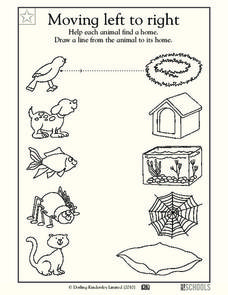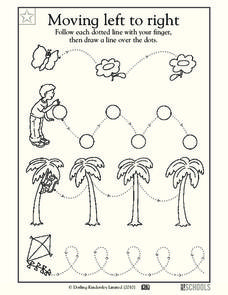Curated OER
l and j
Young printers focus on lowercase letters l and j in a creative way, starting with tracing and printing each letter several times. Next, they apply these skills by tracing the letters to complete an image. These...
Curated OER
g and q
Give printing practice a creative spin as young writers become familiar with the lowercase letters g and q. They trace each letter four times before printing a set on their own in the space provided. The fun twist is that...
Curated OER
v and w
Have fun with lowercase letters v and w as scholars get some printing practice. They use dotted lines and arrows to get some printing practice before writing a set on their own for each letter. Then, they complete an image of...
Curated OER
Writing Letters: c and o
How can you incorporate drawing a dinosaur with printing practice? Here's how! Budding printers trace and write lowercase letters c and o, following guidelines to trace one set before trying another on their own. Then,...
Curated OER
i and t
As emerging printers learn the letters of the alphabet, make it more fun by giving them creative worksheets like this one focused on the lowercase letters i and t. They follow arrows to trace each letter several times...
Curated OER
Creating Letter-shape Patterns #2
Before learners become writers they need to feel comfortable moving a pencil from left to right in various patterns. Use these exercises to give budding printers some fine motor practice. They complete three patterns by tracing a dotted...
Curated OER
Matching Directions
These abstract shapes are pointing in different directions and young scholars determine which ones are oriented the same way. For each of five starting shapes they examine a set of four identical figures pointing in various directions,...
Curated OER
u and y
Who knew the lowercase letters u and y could be so artistic? Learners get creative as they trace and print these letters, working from left to right. Each letter has examples, both traceable and solid. Learners follow the...
Curated OER
Match the Shapes
Which shape is the same? Young geometers match a triangle, circle, rectangle, and square to their identical counterparts, connecting them with a line from left to right. Then, they do the same thing with a set of four circular shapes,...
Curated OER
r and n
Here is some kid-friendly practice with the letters r and n that will ignite your scholars' artistic sides. They connect the dots to trace the lowercase letters before copying them in the space provided. There are two...
Curated OER
Moving Left to Right
These animals need to find their homes! Young scholars help them by drawing lines from each animal on the left to its habitat on the right. There is no guessing to be done here, though; pairs are directly across from one another. They...
Curated OER
Connect the Rhymes
If your budding readers are new to rhyme, this is a visual way to give them practice. They examine familiar sets of objects, matching them to their rhyming partners by drawing a connecting line. Practice left to right skills by asking...
Curated OER
Find the Rhyme
Find the rhyming word. All of these rhyming, single-syllable words have the short i sound, but learners have to determine which ones they are. There are four starting objects each heading a row of three objects. They examine the...
Curated OER
Find the Rhyme
Which of these objects rhymes? There are four starter pictures here, each heading rows of three objects. Learners determine and circle the row object that rhymes with the first one. Then, they connect two of the CVC words with printing...
Curated OER
Connect the Rhymes
Pre-readers benefit from visual context clues like the ones in this rhyme activity. There are two sets of objects here, and scholars connect objects on the left with their rhyming counterparts on the right. Each word has the vowel...
Curated OER
Matching Directions
Which of these shapes is pointing the same way? Pre-readers examine five rows of familiar objects. The first item points to the right for each, and they must determine which of the subsequent items in each row points the same direction....
Curated OER
Odd One Out
Which word doesn't rhyme? As they practice vowel-sound recognition, scholars examine rows of familiar objects to determine which object doesn't rhyme. There are four rows here, each with a beginning image and three subsequent images....
Curated OER
Connect the Rhymes
Connect these rhyming images. There are two sets of six familiar pictures here, and scholars draw a line from the left objects to their rhyming partners on the right. The images may be difficult for learners to identify, so be sure this...
Curated OER
Drawing Straight Lines
Put pencil to paper with a preschool drawing activity. Little ones trace a given squiggle with straight lines, then finish the last line. They fill the rest of the page with straight lines for practice. A good way to start drawing, which...
Curated OER
Moving Left to Right
To get scholars ready for the curves, twists, and turns of alphabet letters, give them this tracing exercise. Early writers follow dotted lines with their finger from left to right first, then trace it with a pencil. The images are...
Curated OER
Moving Left to Right
Get a head start on writing with this fun visual learning exercise. Learners move their pencils from left to right, following the dotted lines. There are four lines here, each following an object's path. Writers get practice with curved,...
Curated OER
Writing Lowercase k and f
Here's some visual printing practice with lowercase letters k and f. Emerging writers trace each letter before trying a few freehand in the space provided. Note that there is no dotted middle line here to keep your...
Curated OER
Left to Right Kittens
Oh no! The kittens have lost their mittens! Help young learners develop fine-motor skills by drawing straight lines from three kittens to their pair of mittens. Use this to show young learners that things move left to right, just like...
Curated OER
Reading and Writing in the Right Direction
Beginning writers practice writing and reading from left to right using green and red dots. You'll need notecards with a green dot on the left side and a red dot on the right side. Do your learners understand that print moves from left...

























